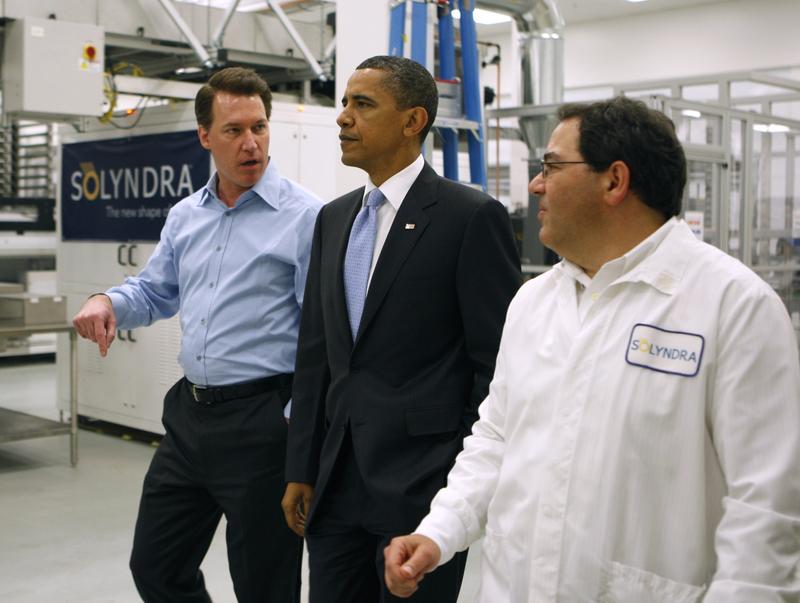
Welcome to Politics Bites, where every afternoon at It's A Free Country, we bring you the unmissable quotes from the morning's political conversations on WNYC. Today on the Brian Lehrer Show, Joe Stephens of the Washington Post explained the scandal surrounding the failed solar company Solyndra, and Lisa Margonelli, director of the Energy Policy Initiative at the New America Foundation, put it in the context of the green energy sector.
When the flagship sinks
The solar company Solyndra was supposed to be America's green energy flagship. Recipients of a $1.5 billion government loan guarantee, (the first company of its kind to get such a deal), Solyndra was to return the taxpayers' investment in the form of solar panels that were cleaner and more efficient than the ones coming out of China.
But China is cornering that market, and while Solyndra was spending money to expand its operation, Chinese companies were lowering their prices. Almost as soon as Solyndra completed its second plant, they were forced to shut down the first one. Now the company has filed for bankruptcy, all employees have been laid off, and the government won't be getting its money back.
It all looks bad for the Obama administration, Joe Stephens said. The president has toured Solyndra and even given a speech there, calling the company "our future."
You would think they were picking the bright shining light for this sector, and on top of that they doubled down on it; they personally put themselves out there. The president doesn't personally go to every company out there that gets government assistance....So it's even more startling when it goes down.
And Solyndra's biggest investor is...
As if buyer's remorse wasn't enough, the Obama administration may have a bigger PR problem stemming from their relationship with Solyndra—their relationship with George Kaiser, billionaire part-owner and, yes, Obama fundraiser. Joe Stephens said that Kaiser was one of the major "bundlers" who would get other people to contribute to the Obama campaign; Kaiser even hosted an event at his home. He's visited the White House "a dozen or so times" according to Stephens.
Is this a case of mutual back-scratching? You round of millions of dollars for my election bid, I fast-track a massive government loan guarantee to the company you run? Could we make this look worse?
Yes. Stephens said that another Obama fundraiser connected to Solyndra was appointed to oversee the management of the loan.
Campaign fundraisers monitoring loans to people with ties to the campaign, that doesn't sound like good government. It's enough to raise questions. That particular individual had recused himself from any dealings with Solyndra because of an issue with his wife, who is an attorney, but...It's murky.
Lender of last resort?
The Solyndra debacle raises questions about everything from money's influence on politics, to the Obama administration's energy intentions, to the wisdom of government subsidies. Lisa Margonelli pointed out that the government stepped in to provide a loan to a company that the market wasn't willing to put on its feet. Perhaps the market was telling us something.
If venture capital and banks aren't willing to fund things, why should the taxpayer be the lender of last resort? For one thing the optics are bad; even when things are good it looks bad, because how is the government making these decisions?
Secondly, venture capitalists aren't like you and me. they are people with weird metabolisms that are interested in risk and willing to take both a left brain/right brain approach to putting money on risky things, and i dont think that government bureaucrats are really set up to do that.
Margonelli said the government has started thinking of itself as a "surrogate venture capitalist," and in this new role it has pushed its labs to produce more commercially-ready ideas. What's falling by the wayside, and what government should be throwing money at, is research.
"Solar panels themselves came out of NASA research," Margonelli said.
Rethinking subsidies
Subsidies need a sea change, and one need not dig deep to find fault with the government's strategy. Lisa Margonelli said that the U.S. taxpayer subsidizes nuclear energy at rate of 140 percent per kilowatt—we're "taking a bath", as Brian Lehrer put it, and Margonelli said it didn't make sense.
We've got an artificially low price for nuclear that's competing with our panels that we're also funding. We need to adjust this business of subsidies and really think about what we want.
Is it a scandal?
This has been bad for the green energy sector and it's been bad for the Obama administration, but is it really a scandal, as so many in the media and especially on the Right have called it?
Joe Stephens doesn't think "scandal" is the right word.
For me, a scandal would mean that you do it for your own personal self-interest, and although there's a lot of smoke out there, no one has proven yet that this was done for political purposes.
Lisa Margonelli said that while the administration certainly didn't have to give Solyndra this money, American politicians have little choice but to invest in solar and other green energies. China is cornering the market precisely because it has the cash to throw at job creation; keeping a billion people employed is necessary for political stability. Solyndra wasn't a wise choice, but the possibility of it being a scandal overshadows the reality that we're falling behind in new technologies.
The amount of energy the world is going to use is going to increase by 53 percent by 2035, and estimates are that the fastest growing sector is going to be green energy. The U.S. has to be in that sector. We have to be competitive if we're going to have a manufacturing sector by 2035. I don't see us as having much of a choice, but we have to understand it's not just about throwing money at them.